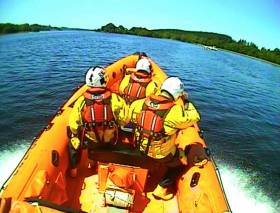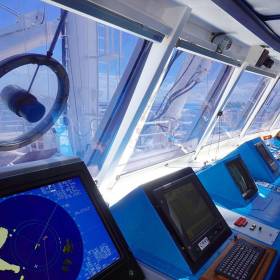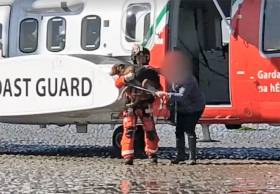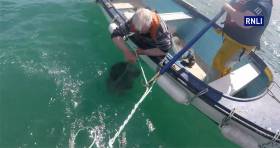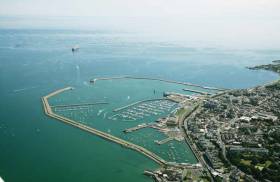Displaying items by tag: Dun Laoghaire
Enniskillen Lifeboat Rescues Two After Boat Fire
#RNLI - Enniskillen RNLI brought two people to safety on Wednesday afternoon (4 July) after their boat they were on showed signs of catching fire.
The two people on board quickly used their fire extinguishers while also phoning 999 to ask for the coastguard.
Belfast Coastguard quickly requested the launch of Enniskillen’s inshore lifeboat Joseph and Mary Hiley, which launched with the rescue water craft to the casualty vessel close to Castle Cauldwell, three miles east of Belleek in Co Fermanagh.
On arrival, Enniskillen RNLI were joined by a passing vessel offering assistance. Conditions at the time were warm and calm and no wind.
The volunteer crew checked that the casualty boat and the owners had extinguished the source of the fire and carried out necessary precautions.
The lifeboat set up a towline and brought the boat and passengers to Magho jetty, where they were met by Northern Ireland Fire and Rescue Service personnel based in Belleek. The boat was checked over again and all were satisfied that the fire was well extinguished.
Following the callout, Enniskillen RNLI helm Adrian Kelly said: “We were happy to assist the vessel back to Magho jetty after the owner had safely deployed his fire extinguishers and prevented serious damage.
“It was encouraging to see that the vessel had adequate safety equipment on board.”
Elsewhere, Dun Laoghaire RNLI responded to a jetskier when his engine failed in Scotsman’s Bay on Tuesday evening (3 July).
The request to launch came in at 7pm after a member of the public alerted the coastguard.
The lifeboat crew of three on Dun Laoghaire’s in-shore lifeboat successfully towed the jetskier safely back to Dun Laoghaire Harbour.
Commenting after the callout, Dun Laoghaire RNLI helm Alan Keville said: “‘It was great to see the jet skier was wearing a lifejacket but he had no means of alerting the coastguard himself. It is essential to always carry a means of communication.”
#RNLI - Dun Laoghaire RNLI responded to a yacht with one man onboard on Saturday afternoon (30 June) when the skipper’s engine failed just outside Bray Head.
The volunteer lifeboat crew were called into action at 16.24pm following a report from the Irish Coast Guard.
The yacht was on passage from Arklow when engine trouble flared just outside Bray Head.
As the country is experiencing a heatwave, weather conditions were near perfect with clear blue skies and good visibility.
The lifeboat crew quickly arrived on scene and successfully towed the yacht and skipper, who was uninjured, safely back to Dun Laoghaire Harbour.
Commenting after the callout, Dun Laoghaire RNLI coxswain Kieran Colley said: “The skipper of the vessel indeed made a good decision in calling for assistance. He was also wearing a lifejacket, which I’m always glad to see. I can’t stress enough how important it is to wear one.”
Later that same day, Lough Derg RNLI launched to assist a family of five on a 25ft cruiser with engine failure in Youghal Bay, off Garrykennedy on the eastern shore of Lough Derg.
Winds were northerly Force 1/2 and visibility was very good when the lifeboat launched at 6.47pm, arriving on scene just four minutes later.
The lifeboat crew — helm Eleanor Hooker, Dom Sharkey and Joe O’Donoghue — found the two adults and three children on board to be safe and unharmed, and wearing their lifejackets. The skipper of the cruiser had dropped anchor to prevent drift.
The cruiser had engine failure that required specialist attention and so the lifeboat volunteer took the casualty vessel under tow to Garrykennedy Harbour, where it was safely tied alongside at 7.13pm.
#CruiseLiners - A boutique yacht-like cruiseship just shy of 10,000 tonnes docked in Dun Laoghaire Harbour this morning as the first of just three callers this season, writes Jehan Ashmore.
The inaugural caller, Star Pride operated by US based Windstar Cruises with 208 guests had sailed from La Pallice, neighbouring La Rochelle on the French coast lining the Bay of Biscay.
On arrival to the south Dublin Bay harbour in the early hours, the former Seabourn Cruise Line vessel berthed at Carlisle Pier. This is where the considerably larger freight ro-ro Stena Carrier as previously reported had initially called first for survey work before again anchoring offshore. Surprisingly, the ship returned to port to enable crew rest until departing earlier this month.
Guests of the high-end luxury Star Pride are pampered in facilities among them lounges, a club, casino, screening room, computer room and library. As far as leisure facilities are concerned, there is a spa, two whirlpools, a swimming pool and a fitness centre. Accommodation comprises of 106 suites, all outside with ocean views.
Star Pride given its small size of 134m long, 19m (beam) wide and 5m draft, has the advantage of calling to destinations involving smaller harbours and secluded coves.
The next caller will be a fleetmate, Star Breeze also a sister which is scheduled but not until September with two calls. As both ships are small, there will be no anchorage callers in Dublin Bay to where considerably larger vessels did so of recent years, though last year the season attracted almost thrice the number of callers with 8 ships and all entering the harbour. Of those only one ship was not operated by Windstar, the expedition cruiseship Serenissima of Noble Caledonia, carrying a mere 85 passengers.
The third and final Windstar sister that visited Dun Laoghaire last year was Star Legend. The Seattle based operator also has a trio of sail-assisted ships, sisters Wind Star and Wind Spirit with four masts each. In addition the larger and impressive Wind Surf featuring five-masts that during calls to Dun Laoghaire has drawn much admiring attention in recent years.
The 310 guest capacity Wind Surf has became the most frequent to since the Dun Laoghaire Harbour Company made a concerted effort to attract the sector back in 2011, three years before the Stena HSS fastferry service to Holyhead closed.
Two Days Till Red Bull Flugtag Returns To Dun Laoghaire
#Flugtag - The long-awaited return of the Red Bull Flugtag to Dun Laoghaire Harbour is just two days away.
As previously reported on Afloat.ie, the event this Sunday 20 May will see over 50 teams attempt to push the limits of human flight as they launch their handcrafted flying machines in front of over 40,000 spectators.
The National Yacht Club invites its members to enjoy the spectacle “from your club’s best vantage point” with a barbecue as well as live music and entertainment from 1pm to 5pm.
Members should also be aware that there will be an exclusion zone in the Carlisle Basin with two patrol RIBs from the club to help channel the traffic.
It is also advised not bring your boat alongside the pontoons, as masts or high cabins would impede the view of the show.
The NYC’s launch service is not affected by the Flugtag, but there will be no renting of club boats this weekend.
For further details on the event, including road closures, parking and public transport, see the official Red Bull Flugtag event guide.
#Coastguard - Dun Laoghaire Coast Guard was alerted at 10am yesterday morning (Wednesday 16 May) to respond to a woman and her dog who were cut off by the tide on Merrion Strand, near the seaward side of the Dublin incinerator area.
Dublin Coast Guard’s Marine Rescue Coordination Centre (MRCC) activated a procedure with consent to ping the location of the casualty’s phone to give co-ordinates to the responding emergency services.
Dun Laoghaire RNLI and the Dublin-based Irish Coast Guard helicopter Rescue 116 responded to the area and were directed in by the Dun Laoghaire coastguard team.
Rescue 116 proceeded to land on the sand bank while Dun Laoghaire RNLI’s inshore lifeboat stood by to assist. A Dublin Fire Brigade RIB from Dublin Port also responded.
The casualty and her dog were airlifted from the sand bank to awaiting coastguard personal on the beach. After checks by Dublin Fire Brigade paramedics, they were taken back from the beach to land.
Dun Laoghaire Coast Guard noted yesterday’s “very fast” spring tide which caught this dog walker unawares. Tide times for Dublin can be found online HERE.
#RNLI - Dun Laoghaire RNLI’s all-weather lifeboat was called out twice in quick succession this afternoon (Wednesday 9 May) to two separate vessels fouled on fishing pots.
The volunteer crew of Dun Laoghaire launched to assist one boat that had been fouled by pots.
Once safely ashore, the crew’s pagers sounded again with a call to assist a yacht that had also become fouled on pots, and towed it into harbour.
The recent vote by Dun Laoghaire Rathdown County Council (DLR) effectively recommends that the Minister for Transport, Tourism and Sport dissolve the Harbour Company and transfer its assets to the County Council. The right to do this is given to the Minister under Article 28 of the Harbours Act 2015, and, importantly, this action is strongly supported by the Nationals Ports Policy.
The debate in the Council Chambers showed that there is an appetite to bring the harbour under the auspices of the County Council, not only amongst the Councillors but also at senior management level. In recommending this course of action, Philomena Poole, DLR’s CEO, addressing the council, stated that this was an “opportunity to use government policy for the betterment of the county and to ensure the integration at a policy and development level of the harbour”.
However, there is the small question of who pays for the works that would put the harbour into a “taking in charge” condition, essentially that state where no capital works are required to prevent further deterioration of the infrastructure. Consultants employed by the County Council estimate this to be €33m, of which approximately €7m covers the outer piers and €8m is for repairing berth no 1 on the East Pier. Councillors were unanimous that the €33m was not something that the county council could or should underwrite and this hot potato was very firmly hurled towards national government. Ironically, recent damage to East Pier during Storm Emma highlighted how DLHC is unsustainable an entity.
There were strong opinions expressed during the debate about the role of the Harbour Company, none of them positive, not only concerning the Harbour Company’s recent progress or lack of it, but also about the non–cooperation with the consultants as they endeavoured to calculate the liabilities. Several referred to the “dysfunctionality” of the Harbour Company while Councillor John Bailey was particularly scathing of the Harbour’s approach noting that the Harbour Company “is dead, not even on life support.” He was to the forefront amongst Councillors concerned that the ‘snapshot’ provided by the consultants through the risk report fell short of the information that would be available in a due diligence report.
A number of motions were withdrawn before the final vote in the interest of getting the principal motion passed. One of these suggested that the Minister effectively impose a “cease and desist” order on the Harbour Company to restrict, inter alia, any transfer of assets and new leases or rental agreements. At present the Harbour Company are actively seeking expressions of interest in the Carlisle Pier regeneration, conducting a “market consultation” on the provision of a national watersport centre and entering a procurement process for the provision of floating homes in the Coal Harbour.
Another motion that was withdrawn was a proposal to create a Harbour Stakeholder’s Committee.
The activity in the Council Chamber begs the question where next? Those who were seeking to engage with the Harbour Company on current projects must be concerned about the longer term viability. With the future governance of the harbour in doubt, where do the current planning applications for developments on harbour lands fit in?
While the County Council vote is indicative of the intent of Dun Laoghaire Rathdown, it is perhaps only the beginning of the end and maybe even back to the drawing board for a new master plan for the harbour.
The council meeting heard that the decision to transfer is wholly reserved to the Minister for Transport.
Is it a bright new future or same old same old for the 200–year–old harbour?
Clearly the ball is now firmly in the Minister’s court.
Read also: Without a Harbour Czar, Dun Laoghaire’s All at Sea
Dun Laoghaire Harbour’s ‘Floating Homes’ Tender Goes Live
#Property - Dun Laoghaire Harbour Company has now launched the procurement process for its plans to develop ‘floating homes’ on the waterfront, as promised in January.
The tender published to the State’s eTenders website is “seeking proposals for the development and operation of affordable floating homes within the harbour” by Thursday 12 April.
The concession notice for the estimated €15 million development stipulates that some 60% of the Coal Harbour area has been earmarked for the plan, which is expected to comprise around “50 single-storey affordable floating homes for rental by the candidate.”
The harbour company adds: “It is important that any development is high quality and sensitive to the site’s high profile waterside location.”
PJ Gallagher & Friends To Hold Dun Laoghaire Comedy Night In Aid Of RNLI
#RNLI - Comedian, radio host and TV personality PJ Gallagher is to hold a night of fun and laughter with some of Ireland’s top comedians to raise funds for the RNLI.
The one-off event is being staged at Dun Laoghaire’s Pavilion Theatre on Sunday 4 March, where PJ will be joined by friends Deirdre O’Kane, Eric Lalor, Joanne McNally and more.
Funds raised on the night will go to help the charity with their work in saving lives at sea and prevention.
PJ became aware of the work of the RNLI in Dun Laoghaire when he was passing the station and lifeboat mechanic Kieran ‘Colley’ O’Connell invited him in to look around.
The pair struck up a friendship, and PJ has been a regular visitor at the station since then. When he heard about he work of the RNLI he made up his mind to do an event to raise funds.
Speaking about his decision to hold the comedy night and to ask some of his famous friends to support it, PJ said: “I live near the lifeboat station and was aware of the work of the RNLI but it was only when I met Colley that I really learned what it was all about. These men and women are volunteers and they leave their jobs and lives to come and help those in trouble at sea.
“We have a big beautiful lifeboat on view in Dun Laoghaire Harbour but when it’s gone, sometimes in the middle of the night, that’s when they are doing their amazing work. I asked some friends if they’d help with a fundraiser and they jumped at the chance. In fairness, you never know when this lot might need rescuing.”
Kieran added: “We are really thrilled that PJ and his friends are holding this night for us. We get a lot of visitors into the station and they are always delighted to hear about the work we do and you hope it stays with them but PJ has stayed in contact and become a firm friend of the station.
“I just hope he knows what he is letting himself in for as most of the crew will be attending and if their pagers go off there could be a lot of people running for the doors suddenly. I hope they won’t take it personally.”
The gig is selling fast, with only a small number of tickets remaining. Tickets are priced at €24 and are available from the box office directly at www.paviliontheatre.ie or 01 231 2929.
Night at the Oskars
Elsewhere, members of Clogherhead RNLI have been overwhelmed with the local support for ‘The Night at the Oskars’, a special night being staged to raise funds for the station’s new Shannon class lifeboat due in 2019.
Taking place on Saturday 3 March at the TLT in Drogheda, the evening will see local people star in seven short films recreating some of the most well-known and successful blockbusters over the last few years.
The red-carpet event is formal or black-tie dress and tickets are priced at €30.
Last June Clogherhead RNLI launched a €150,000 fundraising appeal at the Drogheada Maritime Festival towards the cost of the new Shannon Lifeboat, which is expected to total some €2.5 million.
The majority of the funding will be provided through an Irish legacy, and Clogherhead RNLI and affiliated branches in Meath and Monahan are making a commitment to raise €150,000 towards the cost of the project through a community appeal.
Tickets can be obtained at the Clogherhead Lifeboat Station each Saturday and Sunday from 10am to 2pm until 3 March or through phoning Tomas on 086 809 4690.
Legal Tussle Over Contract For Dun Laoghaire ‘Urban Beach’
#UrbanBeach - A funding dispute over the proposed ‘urban beach’ development for Dun Laoghaire is going to the High Court.
According to Fora, Dun Laoghaire-Rathdown County Council (DLRCoCo) is taking legal action against the Dun Laoghaire Harbour Company to annul the contract between the two parties, alleging lack of progress on a project that was put on hold ‘pending organisational restructure’ in late 2016.
Modelled along the lines of Berlin’s Badeschiff, the development comprising an artificial beach and floating swimming pool barge along the East Pier has been stalled a number of times since first mooted as part of a series of regeneration plans for the harbour.
Up to €1.5 million of the €3 million costs of the project were expected to be funded by DLRCoCo, which has already reportedly paid thousands in arbitration fees over the dispute.
Ownership of the harbour company is supposed to transfer to the local authority, but a year ago county councillors expressed concern over the potential financial liabilities involved, as previously reported on Afloat.ie.
A risk assessment due later this month is expected to shed more light on the situation. Fora has more on the story HERE.



























